Production of Nanocomposite Silver Packaging using Solution Blending Method for the Supplement of Antibacterial Coating
The objective of this study was to assess antimicrobial effects of silver nanoparticles on Gram-positive and Gram-negative bacteria that used in preparing silver nanocomposite with the antibacterial characteristics using solution method. Moreover, the aim of the current study was to produce antimicrobial silver nanocomposites for food coating with their effects on a wide range of bacteria.
To assess antibacterial characteristics of silver nanoparticles, several steps were carried out. First, nanoparticles were synthesized through a chemical reduction method using NaBH4 and then analyzed using x radiation diffraction, ultraviolet and visible spectroscopic analysis, dynamic light scattering and scanning electron microscopy nanometric assays. Then, Staphylococcus aureus and Escherichia coli were used as Gram-positive and Gram-negative bacterial indicators. Minimum inhibitory concentration, minimum bactericidal concentration and inhibition zone levels were measured. Nanocomposite was produced using solution blending method and its antibacterial characteristics were assessed using inhibition zone method.
Results indicated that silver nanoparticles with 20 and 50 µg.l-1 concentrations included inhibitory effects on Staphylococcus aureus and Escherichia coli, respectively. Furthermore, concentrations of 40 to 60 mg.l-1 included lethal effects on Staphylococcus aureus and Escherichia coli, respectively. Based on the results, the highest antibacterial effects were observed on Gram-positive Staphylococcus aureus. In inhibition zone assays, a 3-5 mm zone was seen around the silver nanoparticle discs in cultures of the microorganisms. In the inhibition zone assay of the produced nanocomposites, the zone was expected regarding the concentrations. Results were calculated in three repetitions and the value estimated through ANOVA was significant when p<0.0001. It has been concluded that silver nanoparticles are useful in Gram-positive and Gram-negative bacteria for the inhibition and destruction. Moreover, it has been verified that using the method includes great effects on antibacterial characteristics of the nanocomposites.
پرداخت حق اشتراک به معنای پذیرش "شرایط خدمات" پایگاه مگیران از سوی شماست.
اگر عضو مگیران هستید:
اگر مقاله ای از شما در مگیران نمایه شده، برای استفاده از اعتبار اهدایی سامانه نویسندگان با ایمیل منتشرشده ثبت نام کنید. ثبت نام
- حق عضویت دریافتی صرف حمایت از نشریات عضو و نگهداری، تکمیل و توسعه مگیران میشود.
- پرداخت حق اشتراک و دانلود مقالات اجازه بازنشر آن در سایر رسانههای چاپی و دیجیتال را به کاربر نمیدهد.


